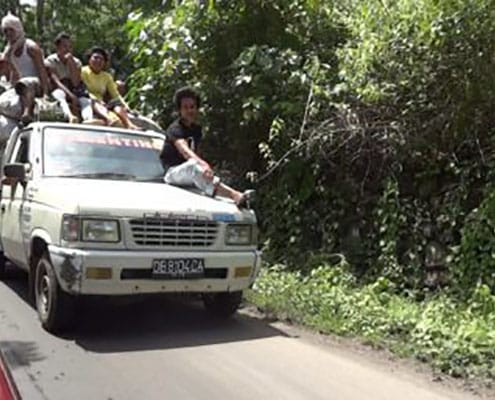
The World Health Organisation estimates that 38,000 people die on Indonesian roads every year. Photo by Flickr user Dillan K.
As in many parts of Indonesia (and Southeast Asia), motorcycles are the primary mode of transport in Minahasa, North Sulawesi. With their manoeuvrability, low operating costs, and durability, motorcycles are a far more attractive transport option than most alternatives. Easy access to credit and a culture of sharing has allowed even poor Indonesians to have access to a “motor”.
Despite these positive aspects, riding a motorcycle is consistently a high-risk undertaking. Basic road rules are only intermittently enforced and outside urban areas people usually view helmets as unnecessary accessories. Added to this is the thrill-seeking behaviour of some testosterone-filled young males, for whom dangerous driving appears to be a way to impress their peers.
In Indonesia, motorcycles can transport anything and everything, for example: entire families of four or five people, gas bottles, furniture, mattresses, windscreens, food for sale, felled tree trunks, and even livestock. This helps the poor but it certainly doesn’t make the roads any safer.
During a period of about 15 months living and working in Minahasa, I have spent hundreds of hours on the roads. My amazement at the dangerous behaviour on the roads is rarely shared by local people, who have a somewhat relaxed attitude to road safety. On two occasions, I narrowly avoided being involved in accidents, one of which would have been entirely my fault. I also witnessed the aftermath of multiple accidents that I estimate resulted in the deaths of six people.
In more rural areas, where health services are limited, road accidents are often fatal. Even if riders and passengers survive the impact, proper medical attention is hard to come by. Local community health clinics (puskesmas) are often poorly equipped to deal with patients in clinical shock or suffering serious injuries. Transportation to a distant hospital or medical centre may only be available in the private vehicles of passers-by, rather than an ambulance.

Photo by Tim Brickell.
Finding accurate statistics on road deaths in Indonesia is difficult. In the World Health Organisation’s “Global Status Report of Road Deaths 2015“, Indonesia is considered “without eligible death registration data”. The WHO report uses regression modelling to estimate the total road death figures for Indonesia, resulting in a figure of 38,279 deaths in 2015, with 36 per cent (13,780) attributed to people on motorcycles. Included in the total are 8,038 (21 per cent) pedestrian deaths. This would appear an unusually high number, but it is not really surprising when one considers that most Indonesian roads lack footpaths and drivers and pedestrians share the same space.
The impact of such a high rate of road deaths on Indonesian society more broadly can only be guessed at, but in a purely financial context the WHO report estimates a cost equal to 2.9-3.1 per cent of total Indonesian GDP, or between US$25-26 billion. And while the number of road deaths is impossible to verify, the WHO figure is equivalent to more than 40 per cent of the total deaths for diabetes in Indonesia, which reached 93,060 in 2014, or almost half the total respiratory deaths (77,550).
At a regional level, the Central Statistics Agency (BPS) in North Sulawesi also lacks statistics on road deaths. Despite the lack of precise figures, anecdotal evidence from my time in Minahasa gives the impression that many road deaths in this region could be prevented.
The fact that road deaths appear to be so prominent should result in a strong government response. To this end, the Indonesian government has drawn up the National Road Safety Plan (RUNK) 2011-2035. This document sets out a target of lowering the number of road related fatalities by 80 per cent by 2035. The strategies for achieving this target are outlined in five “pillars” that focus on issues such as: improving road infrastructure, ensuring vehicles on the road are properly maintained and safe to drive, education relating to behaviour of road users, and improving emergency accident response systems.
While the scope of this plan is admirable, it is unclear whether any concrete reforms have actually occurred, or how much specific funding for reforms has been allocated. In a recent trip to North Sulawesi I did not note any real difference in road users’ behaviour or the enforcement of road rules.
With a population growing at more than 2,600,000 people per year, the number of road users in Indonesia will continue to increase. To reduce the number of motorcycle-related road deaths in North Sulawesi and around the country, a number of issues urgently need to be addressed. The most pressing is the need for accurate statistics to reveal the extent of the problem. There is also a need for cultural change through education on wearing helmets and other safety items, especially in rural areas and among young males. Finally, legislation and enforcement of road laws is essential if real change is to occur.
In the 2015 WHO report, Indonesia scores zero out of five for the factors of speed, drink-driving, helmets, seat-belts, and child restraints. Nonetheless, in more urban areas local police do sometimes check that motorcycle riders are carrying valid registration papers and wearing helmets. This demonstrates that legislating driver behaviour is certainly possible. The question of whether this issue is deemed important enough to result in legislative and bureaucratic change is much more difficult to answer.





